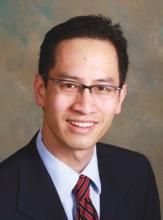BETHESDA, MD. – Surgery is curative in half of patients with refractory temporal lobe epilepsy, yet it is still highly underused – in part because of misperceptions about the risks and benefits, according to Dr. Edward F. Chang.
Dr. Chang, assistant professor of neurological surgery and physiology at the University of California, San Francisco, said that numerous studies have shown that 60%-70% of patients are free of seizures 1 year after surgery and that at least half have seizure freedom over the long term. Also, there are "well-documented quality of life improvements," he said at the meeting sponsored by the National Institute of Neurological Disorders and Stroke.
Sixty percent of people with epilepsy have focal seizures, and the temporal lobe form is the most common type of epilepsy that is characterized by focal seizures, according to NINDS. The Epilepsy Foundation estimates that there are at least 200,000 new cases of epilepsy (any type) in the United States each year.
Based on the totality of the evidence, in 2003 the American Academy of Neurology, the American Epilepsy Society, and the American Association of Neurological Surgeons jointly published a guideline statement (Neurology 2003;60:538-47), urging referral of refractory patients for surgery.
But physicians are still not heeding that guidance, said Dr. Chang. His own survey of clinicians (Neurology 2012;78:1200-6) showed that there had been no increase in surgery in a 5-year period after the joint recommendation. Dr. Chang characterized that as "very depressing in terms of how we are using evidence," especially since there has been an increasing burden of epilepsy. In some cases, patients have lived with epilepsy for 20-30 years before being referred for surgery, he said.
Surgery is safe and effective and the side effects are predictable, he noted, adding that the number needed to treat for one patient with refractory temporal lobe epilepsy to become free of disabling seizures is only two – a number that parallels the use of antibiotics for pneumonia.
"We are below the standard of care," Dr. Chang said. Clinicians and patients shy away from surgery because "of the idea that brain surgery is too dangerous," he said. And physicians don’t understand the data. Drug and device makers also are "spending millions of dollars a year telling patients there are other options," he said, but if "we address this basic utilization problem we’d see an immediate and substantial reduction ... in the burden of epilepsy worldwide."
There have been several advances in surgical technique in the last few years that might make neurologists and patients – who might be spooked by looking at photos and videos of temporal lobe surgery on the Internet – more comfortable. For instance, there are transcortical approaches, which use a small incision to go through the white matter to the hippocampus. With the subtemporal approach, "you don’t have to go through any lateral cortex at all," he noted.
"Even for relatively large lesions that are quite deep in the brain we can actually do these minimally invasive approaches by just going underneath the lateral temporal cortex and selectively removing the hippocampus," Dr. Chang said.
On the horizon, there are nonsurgical minimally invasive techniques under development that have the potential to yield outcomes similar to surgery, he added. NINDS is funding a pivotal trial of stereotactic radiosurgery. The device selectively delivers radiation to the hippocampus and mesial lobe and spares the lateral temporal areas en route. Overall, it is fairly safe, but some patients have severe swelling as long as a year after the procedure and most have no effect for at least a year.
Another approach under study is using MRI to guide laser thermoablation. "A lot of us are quite excited about this," Dr. Chang said. The MRI allows the clinician to accurately place the laser and study how much the tissue is heated, which can help researchers determine whether there is damage and if it might be irreversible.
Finally, there is MRI-guided focused ultrasound, which uses the same principles as radiosurgery to target structures deep in the brain, he said. The procedure is currently in phase III trials for essential tremor.
There is, however, "a lot of irrational exuberance with these technologies," he pointed out.
It is not clear how to validate them, especially since clinicians are currently struggling with how to validate different surgical approaches. A big issue for the surgery trials is that it is difficult to recruit patients. Many have said that they don’t want to participate because they don’t want to be randomized.


